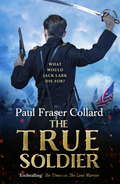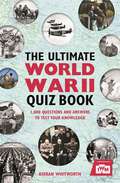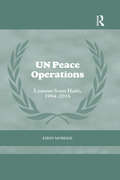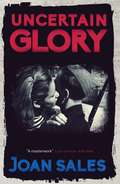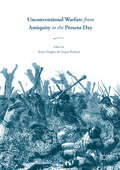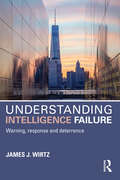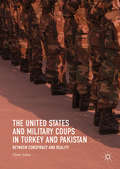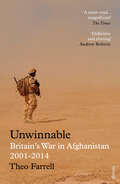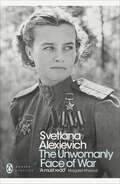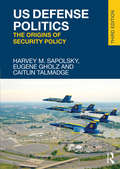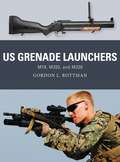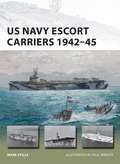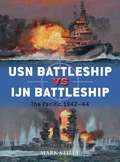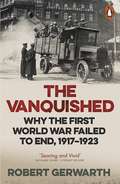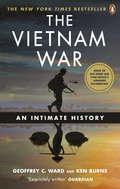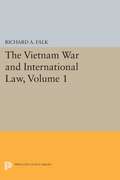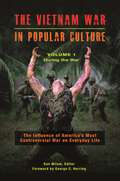- Table View
- List View
The True Soldier (Jack Lark, Book 6): A gripping military adventure of a roguish British soldier and the American Civil War
by Paul Fraser CollardRoguish hero Jack Lark - dubbed 'Sharpe meets the Talented Mr Ripley' - travels to America to reinvent himself as the American Civil War looms... A must-read for fans of Bernard Cornwell and Simon Scarrow. 'Nobody writing today depicts the chaos, terror and brutality of war better than Paul Fraser Collard' Matthew Harffy 'This ain't the kind of war you are used to. It's brother against brother, countryman against countryman'April, 1861. Jack Lark arrives in Boston as civil war storms across America. A hardened soldier, Jack has always gone where he was ordered to go - and killed the enemy he was ordered to kill. But when he becomes a sergeant for the Union army, he realises that this conflict between North and South is different. Men are choosing to fight - and die - for a cause they believe in. The people of Boston think it will take just one, great battle. But, with years of experience, Jack knows better. This is the beginning of something that will tear a country apart - and force Jack to see what he is truly fighting for.
The Ultimate World War II Quiz Book: 1,000 Questions and Answers to Test Your Knowledge
by Kieran WhitworthPublished in association with the Imperial War Museums, this book will provide the ultimate challenge to even the most knowledgeable military historian.You might think you know a great deal about World War II but have you ever really tested your knowledge? This compelling book, published in association with Imperial War Museums, contains over 1,000 questions (and answers, if you need them) that cover every aspect of the Second World War, from its beginnings, though the widening of the conflict, the leaders and their strategies, armies, battles, weapons, bombing raids – everything to provide a real challenge to even the most committed history lover.With multiple-choice questions, truth or fiction sections to baffle and intrigue, picture quizzes from the Imperial War Museums' archive – one of the largest military photographic archives in the world – and much more, you will find there is still something new to learn about this compelling conflict, and your answers will be ranked accordingly.
UN Peace Operations: Lessons from Haiti, 1994-2016 (Cass Series on Peacekeeping)
by Eirin MobekkThis book assesses the UN Peace Operations in Haiti and establishes what lessons should be taken into account for future operations elsewhere. Specifically, the book examines the UN’s approaches to security and stability, demobilisation, disarmament and reintegration (DDR), police, justice and prison reform, democratisation, and transitional justice and their interdependencies through the seven UN missions in Haiti. Drawing on extensive fieldwork and interviews conducted in Haiti, it identifies strengths and weaknesses of these approaches and focuses on the connections between these different sectors. It places these efforts in the broader Haitian political context, emphasises economic development as a central factor to sustainability, provides a civil society perspective, and discusses the many constraints the UN faced in implementing its mandates. The book also serves as a historical account of UN involvement in Haiti, which comes at a time when the drawdown of the mission has begun. In an environment where the UN is increasingly seeking to conduct security sector reform (SSR) within the context of integrated missions, this book will be a valuable contribution to the debate on intervention, UN peace operations and SSR. This book will be of interest to students of peace operations and peacekeeping, conflict studies, security studies and IR in general.
UN Peace Operations: Lessons from Haiti, 1994-2016 (Cass Series on Peacekeeping)
by Eirin MobekkThis book assesses the UN Peace Operations in Haiti and establishes what lessons should be taken into account for future operations elsewhere. Specifically, the book examines the UN’s approaches to security and stability, demobilisation, disarmament and reintegration (DDR), police, justice and prison reform, democratisation, and transitional justice and their interdependencies through the seven UN missions in Haiti. Drawing on extensive fieldwork and interviews conducted in Haiti, it identifies strengths and weaknesses of these approaches and focuses on the connections between these different sectors. It places these efforts in the broader Haitian political context, emphasises economic development as a central factor to sustainability, provides a civil society perspective, and discusses the many constraints the UN faced in implementing its mandates. The book also serves as a historical account of UN involvement in Haiti, which comes at a time when the drawdown of the mission has begun. In an environment where the UN is increasingly seeking to conduct security sector reform (SSR) within the context of integrated missions, this book will be a valuable contribution to the debate on intervention, UN peace operations and SSR. This book will be of interest to students of peace operations and peacekeeping, conflict studies, security studies and IR in general.
Uncertain Glory
by Joan SalesSPAIN, 1937. Posted to the Aragonese front, Lieutenant Lluís Ruscalleda eschews the drunken antics of his comrades and goes in search of intrigue. But the lady of Castel de Olivo - a beautiful widow with a shadowy past - puts a high price on her affections. In Barcelona, Trini Milmany struggles to raise Lluís' son on her own, letters from the front her only solace. With bombs falling as fast as the city's morale, she leaves to winter with Lluís' brigade on a quiet section of the line. But even on 'dead' fronts the guns do not stay silent for long. Trini's decision will put her family's fate in the hands of Juli Soleràs, old friend and traitor of easy conscience, a philosopher-cynic locked in an eternal struggle with himself. Joan Sales, a combatant in the civil war, distilled his experiences into a timeless story of thwarted love, lost youth and crushed illusions. A thrilling epic that has drawn comparison with the work of Dostoevsky and Stendhal, Uncertain Glory is a homegrown counterpart to classics such as Homage to Catalonia and For Whom the Bell Tolls.
Unconventional Warfare from Antiquity to the Present Day
by Brian Hughes Fergus RobsonThis volume addresses the problem of small, irregular, and unconventional war across time and around the globe. The use of non-uniformed and often civilian combatants, with tactics eschewing pitched battles, is the most common form of warfare throughout history and comes in many forms. The collection works back in time beginning with the ‘Long War’ in present day Afghanistan and concluding with warfare in classical Greece. Along the way it engages with conflicts as diverse as the American Civil War and regional rebellion in Tudor England. Each case study provides unique insights into the practices, experiences, and discourses that have shaped this ubiquitous type of conflict. Readers interested in rebellion and repression, cultural and tactical interpretations of conflict, civilian strategies in wartime, the supposed ‘western way of war’, and the ways in which participants have framed and related their actions across a variety of spheres will find much of interest in these pages.
Unconventional Warfare from Antiquity to the Present Day
by Brian Hughes Fergus RobsonThis volume addresses the problem of small, irregular, and unconventional war across time and around the globe. The use of non-uniformed and often civilian combatants, with tactics eschewing pitched battles, is the most common form of warfare throughout history and comes in many forms. The collection works back in time beginning with the ‘Long War’ in present day Afghanistan and concluding with warfare in classical Greece. Along the way it engages with conflicts as diverse as the American Civil War and regional rebellion in Tudor England. Each case study provides unique insights into the practices, experiences, and discourses that have shaped this ubiquitous type of conflict. Readers interested in rebellion and repression, cultural and tactical interpretations of conflict, civilian strategies in wartime, the supposed ‘western way of war’, and the ways in which participants have framed and related their actions across a variety of spheres will find much of interest in these pages.
Under a Sardinian Sky
by Sara AlexanderSometimes a family’s deepest silences hide the most important secrets.
The Undercover Affair: The Hero's Redemption A Family For Christmas The Undercover Affair Last Chance At The Someday Café (Mills And Boon Superromance Ser. #Vol. 2106)
by Cathryn ParryTo choose between justice and love
Understanding Intelligence Failure: Warning, Response and Deterrence (Studies in Intelligence)
by James J. WirtzThis collection, comprising key works by James J. Wirtz, explains how different threat perceptions can lead to strategic surprise attack, intelligence failure and the failure of deterrence. This volume adopts a strategist’s view of the issue of surprise and intelligence failure by placing these phenomena in the context of conflict between strong and weak actors in world affairs. A two-level theory explains the incentives and perceptions of both parties when significant imbalances of military power exist between potential combatants, and how this situation sets the stage for strategic surprise and intelligence failure to occur. The volume illustrates this theory by applying it to the Kargil Crisis, attacks launched by non-state actors, and by offering a comparison of Pearl Harbor and the September 11, 2001 attacks. It explores the phenomenon of deterrence failure; specifically, how weaker parties in an enduring or nascent conflict come to believe that deterrent threats posed by militarily stronger antagonists will be undermined by various constraints, increasing the attractiveness of utilising surprise attack to achieve their objectives. This work also offers strategies that could mitigate the occurrence of intelligence failure, strategic surprise and the failure of deterrence. This book will be of much interest to students of intelligence studies, strategic studies, security studies and IR in general.
Understanding Intelligence Failure: Warning, Response and Deterrence (Studies in Intelligence)
by James J. WirtzThis collection, comprising key works by James J. Wirtz, explains how different threat perceptions can lead to strategic surprise attack, intelligence failure and the failure of deterrence. This volume adopts a strategist’s view of the issue of surprise and intelligence failure by placing these phenomena in the context of conflict between strong and weak actors in world affairs. A two-level theory explains the incentives and perceptions of both parties when significant imbalances of military power exist between potential combatants, and how this situation sets the stage for strategic surprise and intelligence failure to occur. The volume illustrates this theory by applying it to the Kargil Crisis, attacks launched by non-state actors, and by offering a comparison of Pearl Harbor and the September 11, 2001 attacks. It explores the phenomenon of deterrence failure; specifically, how weaker parties in an enduring or nascent conflict come to believe that deterrent threats posed by militarily stronger antagonists will be undermined by various constraints, increasing the attractiveness of utilising surprise attack to achieve their objectives. This work also offers strategies that could mitigate the occurrence of intelligence failure, strategic surprise and the failure of deterrence. This book will be of much interest to students of intelligence studies, strategic studies, security studies and IR in general.
The United States and Military Coups in Turkey and Pakistan: Between Conspiracy and Reality
by Ömer AslanThis comparative study explores the involvement of the United States in four successful military coups in Turkey and Pakistan during the Cold War. Focusing on military-to-military relations with the US in each country, the book offers insight into how external actors can impact the outcomes of coups, particularly through socialization via military training, education, and international organizations such as NATO. Drawing upon recently declassified government documents and a trove of unexplored interviews with high-ranking officials, Ömer Aslan also examines how coup plotters in both countries approached the issue of US reaction before, during, and after their coups. As armed forces have continued to make and unmake Turkish and Pakistani governments well into the twenty-first century, this volume offers original, probing analysis of the circumstances which make coups possible.
The United States and Military Coups in Turkey and Pakistan: Between Conspiracy and Reality (PDF)
by Ömer AslanThis comparative study explores the involvement of the United States in four successful military coups in Turkey and Pakistan during the Cold War. Focusing on military-to-military relations with the US in each country, the book offers insight into how external actors can impact the outcomes of coups, particularly through socialization via military training, education, and international organizations such as NATO. Drawing upon recently declassified government documents and a trove of unexplored interviews with high-ranking officials, Ömer Aslan also examines how coup plotters in both countries approached the issue of US reaction before, during, and after their coups. As armed forces have continued to make and unmake Turkish and Pakistani governments well into the twenty-first century, this volume offers original, probing analysis of the circumstances which make coups possible.
Unwinnable: Britain’s War in Afghanistan, 2001–2014 (Everyman's Library CLASSICS)
by Theo FarrellChosen as a Book of the Year by the Sunday Times and the Evening Standard'Authoritative and provocative… For its range and breadth, it is a tour de force and a must read' Evening StandardIt could have been a very different story.British and US forces could have successfully withdrawn from Afghanistan in 2002, having done the job they set out to do: to defeat al-Qaeda and stop it from launching further terrorist attacks against the West. Instead, British troops became part of a larger international effort to stabilise the country. Yet over the following thirteen years the British military paid a heavy price for their presence in Helmand province; and when Western troops departed from Afghanistan in 2014, they had failed to stop a Taliban resurgence. In this magisterial study, Theo Farrell explains the origins and causes of the war, providing fascinating insight into the British government’s reaction to 9/11 and the steps that led the British Army to Helmand. He details the specific campaigns and missions over the subsequent years, revealing how the military’s efforts to create a strategy for success were continually undermined by political realities in Kabul and back home. And he demonstrates conclusively that the West's failure to understand the dynamics of local conflict in the country, and to tackle Afghan government corruption, meant that the war was unwinnable.Drawing on unprecedented access to military reports and government documents, as well as hundreds of interviews with Western commanders, senior figures in the Taliban, Afghan civilians and British politicians, Unwinnable is an extraordinary work of scholarship. Its depth of analysis, scope and authority make it the definitive history of Britain’s War in Afghanistan.
The Unwomanly Face of War: An Oral History Of Women In World War Ii (Penguin Modern Classics)
by Larissa Volokhonsky Richard Pevear Svetlana AlexievichThe long-awaited translation of the classic oral history of Soviet women's experiences in the Second World War - from the winner of the Nobel Prize in LiteratureBringing together dozens of voices in her distinctive style, The Unwomanly Face of War is Svetlana Alexievich's collection of stories from Soviet women who lived through the Second World War: on the front lines, on the home front, and in occupied territories. As Alexievich gives voice to women who are absent from official narratives - captains, sergeants, nurses, snipers, pilots - she shows us a new version of the war we're so familiar with, creating an extraordinary alternative history from their private stories.Published in 1985 in Russia and now available in English for the first time, The Unwomanly Face of War was Alexievich's first book and a huge bestseller in the Soviet Union, establishing her as a brilliantly revolutionary writer.
US Defense Politics: The Origins of Security Policy
by Harvey M. Sapolsky Eugene Gholz Caitlin TalmadgeThis book provides an accessible overview of US defense politics for upper-level students. This new edition has been fully updated and revised, with a new chapter on veterans and new material on topics such as cyberwarfare and lobbying. Analyzing the ways in which the United States prepares for war, the authors demonstrate how political and organizational interests determine US defense policy and warn against over-emphasis on planning, centralization, and technocracy. Emphasizing the process of defense policy-making rather than just the outcomes of that process, US Defense Politics departs from the traditional style of many other textbooks. Designed to help students understand the practical side of American national security policy, the book examines the following key themes: US grand strategy; who joins America's military; how and why weapons are bought; the management of defense; public attitudes toward the military and casualties; the roles of the president and the Congress in controlling the military; the effects of 9/11 and the Global War on Terror on security policy, homeland security, government reorganizations, and intra- and inter-service relations. The third edition will be essential reading for students of US defense politics, national security policy, and homeland security, and highly recommended for students of US foreign policy, public policy, and public administration.
US Defense Politics: The Origins of Security Policy
by Harvey M. Sapolsky Eugene Gholz Caitlin TalmadgeThis book provides an accessible overview of US defense politics for upper-level students. This new edition has been fully updated and revised, with a new chapter on veterans and new material on topics such as cyberwarfare and lobbying. Analyzing the ways in which the United States prepares for war, the authors demonstrate how political and organizational interests determine US defense policy and warn against over-emphasis on planning, centralization, and technocracy. Emphasizing the process of defense policy-making rather than just the outcomes of that process, US Defense Politics departs from the traditional style of many other textbooks. Designed to help students understand the practical side of American national security policy, the book examines the following key themes: US grand strategy; who joins America's military; how and why weapons are bought; the management of defense; public attitudes toward the military and casualties; the roles of the president and the Congress in controlling the military; the effects of 9/11 and the Global War on Terror on security policy, homeland security, government reorganizations, and intra- and inter-service relations. The third edition will be essential reading for students of US defense politics, national security policy, and homeland security, and highly recommended for students of US foreign policy, public policy, and public administration.
US Grenade Launchers: M79, M203, and M320 (Weapon)
by Gordon L. Rottman Johnny Shumate Alan GillilandIn an effort to provide the US infantryman with more firepower to cover the range gap between the hand grenade and the light mortar, the 40mm M79 grenade launcher – a shoulder-fired, single-shot weapon – entered service with US forces in 1961.Reliable, easy to use, and lethally effective, the M79 soon became an iconic symbol of the Vietnam War and had a profound influence on small-unit tactics. As the Vietnam conflict continued, it was joined on the front line by experimental models such as the magazine-fed T148E1, as well as two launchers intended to be fitted under the barrel of the new M16 assault rifle: Colt's XM148 and AAI Corporation's M203. The M203 remains in US Army service today, while the US Marine Corps now also fields the M32 multiple grenade launcher – like the M79, a standalone weapon. Featuring full-colour artwork, this is the story of the rugged and formidable grenade launchers that equipped the United States and its allies in Vietnam and beyond from the 1960s to the present day.
US Navy Escort Carriers 1942–45 (New Vanguard #251)
by Mark Stille Mr Paul WrightWhile not as famous as their larger and faster sister ships such as the Essex- and Yorktown-class carriers, escort carriers made an enormous contribution towards Allied victory both in the Pacific and Atlantic theatres. Rather than relying on size or speed, it was their sheer numbers that made them so effective. Indeed, the Casablanca-class escort carrier was the most-produced aircraft carrier in history. In partnership with the Royal Navy, they provided the backbone of Allied anti-submarine efforts in the Atlantic, finally and irrevocably turning the tide of the war against the U-boats in 1943. In the Pacific, they provided the air cover for the series of landings which led to the doorstep of Japan by 1945. These robust ships faced submarine, air, and even surface threats from the Japanese, but proved able to contend with everything thrown their way.Fully illustrated with contemporary photographs and unique specially commissioned artwork, this book shines a new light on these unjustly overlooked workhorses of the US Navy – ships that helped usher in the Allied victory over the Axis powers in the Atlantic and Pacific.
USN Battleship vs IJN Battleship: The Pacific 1942–44 (Duel #83)
by Paul Wright Mark Stille Alan GillilandIn the build-up to World War II both the United States and Japan believed their battleships would play a central role in battle, but after the Pacific War began in December 1941, the role of the battleship proved to be much more limited than either side expected. There would be only two battleship vs battleship actions in the Pacific in World War II, both of which are assessed in this engaging study. At Guadalcanal in 1942, Kirishima faced two modern US battleships, USS Washington and USS South Dakota. In the Surigao Strait in 1944, two World War I-era Japanese battleships, Yamashiro and Fuso, faced six American battleships supported by four heavy cruisers in history's last-ever clash between battleships.Employing full-colour artwork, carefully selected archive photographs, and expert analysis, former US Navy Commander Mark E. Stille examines the two head-to-head clashes between the battleships deployed by the United States and Japan in the struggle for control of the Pacific during World War II.
USS Lawrence vs HMS Detroit: The War of 1812 on the Great Lakes (Duel)
by Mark Lardas Mr Paul WrightThe most critical naval fighting during the War of 1812 took place, not on the high seas, but on the inland lakes of North America: the Great Lakes and Lake Champlain. Carrying between 12 and 22 cannon, the British and American sloops-of-war were ship-rigged, brig-rigged or schooner-rigged vessels. Lakes actions often involved two ships facing each other broadside to broadside, the best example of which was the battle of Lake Erie in 1813 where HMS Detroit led a Royal Navy squadron against the USS Lawrence-led US Navy.Featuring full-colour artwork, this lively study investigates the prolonged struggle between British and US sloops-of-war, highlighting the differences between the war on the lakes and the war on the oceans during the Age of Fighting Sail. It reveals the circumstances under which these ships were built, how they were armed, and the human story behind their construction and use in battle.
The Vanquished: Why the First World War Failed to End, 1917-1923
by Robert Gerwarth'This war is not the end but the beginning of violence. It is the forge in which the world will be hammered into new borders and new communities. New molds want to be filled with blood, and power will be wielded with a hard fist.' Ernst Jünger (1918)For the Western allies 11 November 1918 has always been a solemn date - the end of fighting which had destroyed a generation, and also a vindication of a terrible sacrifice with the total collapse of their principal enemies: the German Empire, Austria-Hungary and the Ottoman Empire. But for much of the rest of Europe this was a day with no meaning, as a continuing, nightmarish series of conflicts engulfed country after country. In this highly original, gripping book Robert Gerwarth asks us to think again about the true legacy of the First World War. In large part it was not the fighting on the Western front which proved so ruinous to Europe's future, but the devastating aftermath, as countries on both sides of the original conflict were wrecked by revolution, pogroms, mass expulsions and further major military clashes. If the War itself had in most places been a struggle purely between state-backed soldiers, these new conflicts were mainly about civilians and paramilitaries, and millions of people died across central, eastern, and south-eastern Europe before the USSR and a series of rickety and exhausted small new states came into being. Everywhere there were vengeful people, their lives racked by a murderous sense of injustice, and looking for the opportunity to take retribution against enemies real and imaginary. Only a decade later, the rise of the Third Reich and other totalitarian states provided them with the opportunity they had been looking for.
The Vietnam War: An Intimate History
by Geoffrey C. Ward Ken BurnsThis definitive account is perfect for any history-buff this Father’s day.**The New York Times Bestseller****The book of the landmark documentary, The Vietnam War, by Ken Burns and Lynn Novick**The definitive work on the Vietnam War, the conflict that came to define a generation, told from all sides by those who were there.More than forty years after the Vietnam War ended, its legacy continues to fascinate, horrify and inform us. As the first war to be fought in front of TV cameras and beamed around the world, it has been immortalised on film and on the page, and forever changed the way we think about war.Drawing on hundreds of brand new interviews, Ken Burns and Geoffrey C. Ward have created the definitive work on Vietnam. It is the first book to show us the war from every perspective: from idealistic US Marines and the families they left behind to the Vietnamese civilians, both North and South, whose homeland was changed for ever; politicians, POWs and anti-war protesters; and the photographers and journalists who risked their lives to tell the truth. The book sends us into the grit and chaos of combat, while also expertly outlining the complex chain of political events that led America to Vietnam.Beautifully written, this essential work tells the full story without taking sides and reminds us that there is no single truth in war. It is set to redefine our understanding of a brutal conflict, to launch provocative new debates and to shed fresh light on the price paid in ‘blood and bone’ by Vietnamese and Americans alike.
The Vietnam War and International Law, Volume 1
by Richard A. FalkInternational lawyers and distinguished scholars consider the question: Is it legally justifiable to treat the Vietnam War as a civil war or as a peculiar modern species of international law?Originally published in 1968.The Princeton Legacy Library uses the latest print-on-demand technology to again make available previously out-of-print books from the distinguished backlist of Princeton University Press. These editions preserve the original texts of these important books while presenting them in durable paperback and hardcover editions. The goal of the Princeton Legacy Library is to vastly increase access to the rich scholarly heritage found in the thousands of books published by Princeton University Press since its founding in 1905.
The Vietnam War in Popular Culture [2 volumes]: The Influence of America's Most Controversial War on Everyday Life [2 volumes]
by Editor Ron MilamCovering many aspects of the Vietnam War that have not been addressed before, this book supplies new perspectives from academics as well as Vietnam veterans that explore how this key conflict of the 20th century has influenced everyday life and popular culture during the war as well as for the past 50 years.How did the experience of the Vietnam War change the United States, not just in the 1950s through the 1970s, but through to today? What role do popular music and movies play in how we think of the Vietnam War? How similar are the recent wars in Iraq and Afghanistan—and now Syria—to the Vietnam War in terms of duration, cost, success and failure rates, and veteran issues? This two-volume set addresses these questions and many more, examining how the Vietnam War has been represented in media, music, and film, and how American popular culture changed because of the war.Accessibly written and appropriate for students and general readers, this work documents how the war that occurred on the other side of the globe in the jungles of Vietnam impacted everyday life in the United States and influenced various entertainment modes. It not only covers the impact of the counterculture revolution, popular music about Vietnam recorded while the war was being fought (and after), and films made immediately following the end of the war in the 1970s, but also draws connections to more modern events and popular culture expressions, such as films made in the aftermath of September 11, 2001. Attention is paid to the impact of social movements like the environmental movement and the civil rights movement and their relationships to the Vietnam War. The set will also highlight how the experiences and events of the Vietnam War are still impacting current generations through television shows such as Mad Men.
